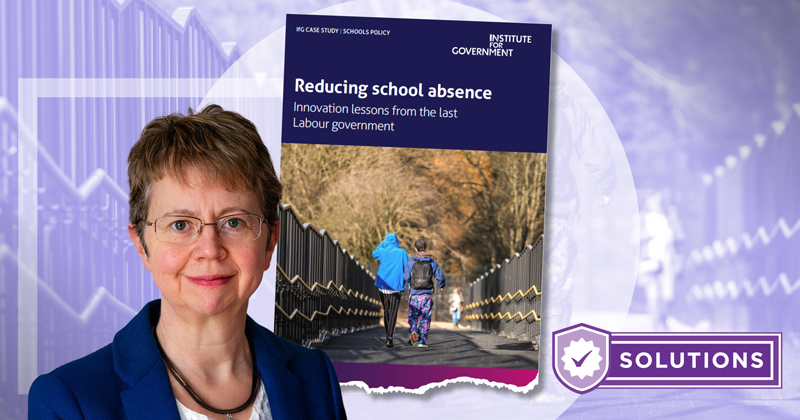The government should “mobilise a national effort” and revive “public targets” to halve persistent absence, according to the guru who spearheaded New Labour’s huge school attendance boost.
Moira Wallace led the Social Exclusion Unit, which was set up by Tony Blair in 1997 in the Cabinet Office to drive down high absence rates with a “joined-up solutions to joined-up problems”.
By investing hundreds of millions in programmes and setting reduction targets, severe absence in secondary schools was halved and persistent absence cut by 45 per cent. Overall absence at secondary school fell from 9 to 5.2 per cent.
In a new paper for the Institute for Government, Wallace has now set out a blueprint for how the new Labour government can solve a new absence crisis.
Here’s the main recommendations.
1. Bring back attendance targets…
The decision to set public targets “was a key ingredient in the success of absence policy in the 2000s, providing the spur to match resource and attention to the scale of the problem”, Wallace says.
Targets were ditched by the coalition government and absence rates started rising again in 2013.
Rates then soared during the Covid pandemic and have remained stubbornly high since.
Wallace said a “sensible aspiration would be to match past success in reducing the most serious forms of absence” – which means targeting a 45 per cent reduction in persistent absence rates and halving severe absence over seven years.
Alternatively, targets focused on pupils eligible for free school meals and those with special educational needs and disabilities “would focus action on disadvantaged groups who are disproportionately likely to miss school”.
2. …but don’t expect schools to do all the work
However, expecting schools to tackle absence alone “will not work”.
Instead, government should “mobilise a national effort to tackle absence and children missing school”.
This should include support from the Treasury to give schools and local authorities the resources they need, and “close partnerships” with other Whitehall departments that influence some of the drivers.
A comprehensive long-term strategy should be led by a national delivery board chaired by a DfE minister.
3. And get health involved too
Illness remains the single biggest cause of school absence.
The DfE and the Department of Health and Social Care “need to ask what can be done to reduce the amount of illness experienced by children, ensure children get access to treatment as fast as possible, and support those who are ill to keep learning when they cannot be at school”, Wallace added.
4. Time to recognise other factors too
Last time it was in government, Labour had success because of a “broad-based strategy that tackled the multiple drivers of absence.
“But over the last decade absence policy has skirted the big issues of adolescent health, problems in the special needs system, school disengagement, family stress, and the fear of bullying and crime,” Wallace said in her report.
To reduce absence successfully government “will need to go further in recognising and communicating all the factors that drive the current absence problem”.
5. Work needed on SEND, curriculum, post-16
The report found “well-resourced schools, adequate support for special educational needs, a curriculum that is appropriate for pupils’ interests and needs, and attractive routes for post-16 progression all appear to have helped improve attendance in the past”.
To get on top of absence, DfE will “need to achieve a recovery in all these areas, as part of an overall drive to make schools supportive, safe and engaging places of learning that motivate pupils rather than push them away”.
6. Support, don’t blame parents
The state “rightly expects parents to support their child’s attendance at school”.
But that “should not slip into assuming that it is inevitably parents’ fault if their children don’t attend”.
Parents who are struggling and worried “need help and advice above all”.
“Strengthening parents’ ability to support their children, and building trusting relationships between home and schools, was part of success in the past and will be key to success in the future.”
7. Re-establish partnerships
Local partnership working on children’s issues has been “under severe strain in recent years, both from funding pressures, and the move to academisation and geographically scattered multi-academy trusts.
Government will need to “re-establish robust and empowered local partnerships, and work closely with them towards a shared purpose.
DfE should push for local partnerships to develop further, inviting local authorities to the table alongside schools and trusts, establishing regular conversations about absence.
8. Learn from New Labour-era programmes
Under the Blair government, two key spending programmes “kick-started improvement”, Wallace said.
Excellence in Cities aimed to improve educational achievement in disadvantaged areas. It provided resources for learning mentors to help pupils with academic or personal issues, and funded in-school learning support units.
The Behaviour Improvement Programme also began in 2002. It embedded action on absence alongside behaviour and school exclusion. By 2005, it had spent £331 million.
The report found these schemes served as “catalysts for successful innovation on absence, behaviour and attainment”.
They combined central investment and local partnership with “freedom to tailor action to local circumstances”.
“Nearly 25 years on, it would be a smart move for DfE to create a modern equivalent to these, to require and support a joined-up local response to absence problems that go beyond the remit of any one agency, school or group of schools.”
9. ‘Watch the data like a hawk’
The government is also being urged to “watch the data like a hawk, evaluate and adapt”.
Close monitoring of progress and evaluation of policies were “key to the last Labour government’s school absence programme. They should come to the fore again now.
“With virtually real-time data on weekly absence, as well as plentiful information on key drivers such as children’s perceptions of school, and experience of bullying, the government has an enormous advantage over its predecessors and should make the most of it.”








Nothing new here!
Same old, get kids as young as possible in school for childcare so parents can get to work. We need those taxes to pay the latest government whims.
Who cares about the quality of education so long as we have 100% attendance.
Ignore sickness and bullying. Ignore parents, SEN, disabilities and hospital appointments.
State Childcare, oh sorry meant to use government terminology ‘State Education’ will accept no valid explanations and will implement no improvements to a very under funded broken institution.